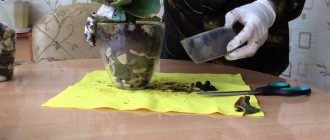Reproduction methods
There are several ways to propagate ficus at home; let’s look at them in more detail.
Apical cuttings
In this case, you need a piece of stem (often this is the growing tip), it should be about 10-15 cm in length. Remove all leaves, if sap is oozing, wait until it stops, usually within 30 minutes, and then wash it off thoroughly.
Spring and summer are the ideal time to propagate the plant. At this time, growth is more active, which means the root system will form faster. A mixture of sand, peat and perlite is poured into the pot. All available cuttings are planted in the ground, covered with a plastic bottle or plastic bag to create a greenhouse effect. They strictly monitor the temperature, which should be at 25 degrees.
Sheet plates
This is another way you can propagate a plant at home. True, this method is not suitable for all varieties, but it can be used for young ficus. Spring is the best time; before winter, the plant has time to adapt and take root.
The step-by-step process is as follows.
- A leaf with an internode is cut from the stem, and not only the main one must be made, but also an additional oblique cut for the rapid formation of roots.
- First, to remove unnecessary juice, the leaf is immersed in water for an hour. After this, it is transferred to a liquid with a stimulant.
- To prevent moisture evaporation through the leaf plate, it is recommended to tie it in a tube.
- When the roots appear, you can transfer the plant to the ground. Immersion in the soil is carried out up to the petiole. After this, the ground is watered, it can be sprayed with a spray bottle and covered with film to create greenhouse conditions.
- If the humidity is at 80% and the room temperature is from 25 to 28 degrees, then within a month new shoots will begin to appear.
Air layering
This method is used when the trunk is very exposed. Small cuts are made along it at a distance of three centimeters, and the bark is removed. “Kornevin” is applied to this place, sphagnum moss is applied, sprayed with a spray bottle, and covered with film. From time to time, make sure that the moss does not dry out. When the roots break through the polyethylene, the sprout can be transplanted into a separate pot.
Seeds
This method is not used often, since it is not so easy to get seeds, but if you are lucky, planting is carried out as follows.
- A mixture of sphagnum moss and peat is used as soil. It must be constantly moist, this is the only way to germinate the seeds.
- The container is covered with film, as soon as the first roots appear, each shoot is planted in a pot. The composition of the soil changes; to root the plant, it is necessary to use a mixture of perlite, river sand and peat.
- While the ficus is rooting, provide it with diffused light, abundant watering in the summer and a small amount of moisture in the winter.
- The upper parts are pinched, leaving only a couple of internodes, which in the future will become the basis for the formation of the crown.
Root
This is a very effective method, which is often used by plant growers. The cuttings are prepared in advance, they are cut from the common root system, and all sections are treated with crushed activated carbon.
One piece can be divided into several parts, each is immersed in the ground, leaving a few centimeters on top of it, and covered with film on top. If everything is done correctly and the soil is well moistened, then within a few months the first leaves will begin to appear. When there are four or more of them, you can remove the plastic bag, since the new plant needs to get used to the surrounding conditions.
What kind of pot is needed for ficus
It is believed that unglazed clay pots for indoor flowers are the best option because the clay is porous and allows air to circulate. This has a positive effect on both the regulation of soil moisture and the supply of oxygen to the roots. However, ficus plants are not picky about the material from which the container is made - it can be ceramic, clay or plastic. The only thing that all types of crops fundamentally need are drainage holes and a “spout” on the tray to drain excess liquid. You can plant a young ficus or transplant an adult plant even into a cheap plastic pot - and if you follow simple care rules, the owner of the flower will receive a healthy and well-developed flower, bush or tree.
Pot shape
For most “natural” ficus plants (that is, excluding trees formed in the bonsai style), standard-shaped pot models with approximately equal height and diameter, as well as holes at the bottom (to ensure drainage of the plantings), are suitable.
When choosing a vessel for ficus, you should remember that replanting this crop is rarely carried out due to its slow growth, and in addition, the flower itself perceives this procedure as stress, reacting by dropping foliage. Therefore, issues of the shape and design of the pot are decided in advance and a flower is planted in it, taking into account that in the next year or three it will not be injured by changing the “house”.
In particular, experts do not recommend using round, ball-shaped pots. It is difficult to remove plants from them when transplanting, and ficuses get sick when their roots are severely injured.
Deciding on the size
The disproportion in the size of the plant (together with the root system) and the container for it sometimes leads to problems: in a pot that is too large, the soil dries slowly, increasing the flower’s susceptibility to root rot. If the pot is too small, the bush or tree may topple under the weight of the branches.
The size of a ficus pot is determined by the size of the root system: when placing it in the pot, two centimeters should remain to its walls (it is difficult to use a ruler in such cases. Practicing flower growers simply place two fingers on the root ball). A more “free” container, instead of benefit, can destroy the plant - too much moisture, harmful to it, will be retained in excess soil.
In cramped containers, the ground part of a bush or tree develops more strongly, while in free containers the root system increases, and the growth of ground mass is inhibited. Therefore, when replanting, either change the soil, leaving the same pot, or select a container 2-4 cm larger in diameter than the previous one.
How to treat ficus
Watch your green pet carefully and provide him with assistance in a timely manner.
Ficus sheds leaves
This happens for various reasons:
- rearranging the plant or reacting to new conditions after purchase;
- drafts from ventilation, cold air from air conditioning systems;
- sudden changes in temperature;
- watering with cold water;
- low air humidity;
- lack of light;
- overflow or overdrying;
- spider mite
Pay attention to the conditions under which the plant is kept. This will help identify and eliminate the cause
If small-leaved species lose up to 10 leaves when winter sets in, nothing needs to be done. This is the plant's reaction to the change of season.
If it's all about a mite, which can be identified by a barely visible web, give the ficus a warm shower. Then treat with acaricides according to the instructions. Insect control products will not cope with this pest.
The leaves are drying at the edges
Overflow is to blame.
This problem often occurs with rubber-bearing ficuses. If symptoms appear, remove the rotted roots and replant the plant in a new pot. Afterwards, try to water moderately.
Damaged leaves will not recover, but new ones will grow healthy.
Leaves droop and fall
This is also a reaction to overflow. Review your watering schedule. Check every time to see if the soil is dry enough.
If overwatering, try drying the soil with paper towels. Place one in the tray, and when it gets wet, change to the next one. Continue until the moisture comes out.
If the situation does not improve, transplant the ficus into a new pot. Before doing this, dry the soil again.
A lush-leaved representative of the mulberry family is ficus. Care at home, the nuances of proper pruning, as well as methods of plant propagation will be described in detail in this article. Ficus has many varieties, varying in size, shape and color of foliage, and some representatives can even reach thirty meters in height. But this is in nature. At home we will not meet such giants. It is quite difficult to imagine a cozy home environment without indoor plants. They delight us with their beauty and bright colors and bring health benefits.
As for indoor varieties, one of the most popular is Ficus Benjamin, which has already become a real “star” of home plant growing.
How to choose a pot and soil
Before you start transplanting Ficus Benjamin at home, you need to select a suitable pot and soil in advance. When choosing a pot, it is better to give preference to a container that is not too large, 2-3 cm higher and wider than the one in which the ficus is located at the time of replanting.
It doesn’t matter what the pot is made of; it could be ceramic, clay or plastic. Each option has its own advantages and disadvantages: natural materials absorb moisture well, but are quite heavy and fragile, plastic products are lighter, inexpensive and attract with their unusual colors
The next step is filling the pot with suitable soil. To begin with, drainage is placed at the bottom, ensuring the outflow of water into the pan after watering and good air permeability of the soil.
Note! Ficus soil needs neutral acidity. You can purchase a ready-made substrate or prepare it yourself
In the latter case, it is necessary to perform the following steps, including soil disinfection:
You can purchase a ready-made substrate or prepare it yourself. In the latter case, it is necessary to perform the following steps, including soil disinfection:
- Prepare the ingredients for the soil mixture (river sand, peat, leaf and turf soil).
- Combine both types of soil, sand and peat in a ratio of 2:2:1:1.
- Dilute the potassium permanganate solution in a separate bowl or simply boil water.
- Pour boiling water or potassium permanganate over the prepared soil mixture to destroy possible pests and pathogenic bacteria.
This procedure is mandatory when transplanting any plants. This allows you to disinfect the soil and promotes better survival of the flower in the new soil.
Preparation of soil mixture
Where to put ficus
Immediately choose a permanent place in the apartment for the green pet. Ficus trees react very painfully to frequent moves.
A well-lit place is suitable for the plant. But make sure that direct sunlight does not fall on the ficus and shade it slightly, for example, with roller blinds. Otherwise he may get burns.
Bright lighting is especially important for variegated plants. Due to lack of light, their leaves can change color and become simply green.
Another consequence of a lack of lighting is curvature or tilting to one side, which is barely noticeable at first. To help your ficus, move it closer to the window. If the plant does not fit on the windowsill, place it on a stool.
From spring to autumn, during active growth, turn the ficus with the other side towards the light once a month.
Ficus propagation by cuttings
The plant is propagated by cuttings, layering and seeds. Propagation by cuttings and seeds is most often used, so these two methods will be discussed below.
The most common method of propagation is cuttings. It is carried out as follows. In the spring, take young branches with leaves and cut them off under the lower node with an oblique cut. The lower leaf blades will be removed.
It is necessary to wash off the juice from the cutting site and place the cuttings in water or damp sand. Then the cuttings should be sprayed and covered with caps made of plastic bottles. After this, the planting material is moved to a shaded, warm place for rooting. From time to time, the caps need to be removed and the plants ventilated.
Once your ficus plants begin to grow, they can be transplanted into pots containing ficus soil for further growth, caring for them as you would regular plants.
Cuttings can be obtained not only from branches, but also from leaf plates, cutting them off along with the “heel”. To root the leaves, they should be rolled up and buried in damp sand, placing sticks nearby for support.
Then they are sprayed and put on caps made from plastic bottles. From time to time they should be removed for watering, ventilation and spraying. Once the cuttings have taken root, they can be transplanted into pots to continue growing as young plants.
Is it possible to plant several flowers in one container?
Ficus trees are often used in the interior design process. If you plant 2-3 shoots in one flowerpot, you can form a beautiful composition from them. But to do this, you need to understand how to properly weave together several trunks.
Interesting! Young stems of the plant are characterized by increased flexibility. This allows you to carry out various manipulations with them. Adult specimens are not suitable for this.
When planting several trees in one pot, the following recommendations must be followed:
- Choose indoor crops of the same height - within 15-17 cm.
- If the trunk is woody by more than half, such a plant is no longer suitable for creating a composition. It may break during the weaving process.
- If there are only two plants, they can be braided in a spiral shape.
- In the case of using dwarf varieties, it is enough to twist the trunk once. For other trees, you can continue to twist their stems as they grow.
- Volumetric or tall flowers require additional support during the weaving period. Then the tree will be protected from distortions and falls. After the process is completed, the frame can be removed.
- It is advisable to secure the contact points of the shoots with wire or strong threads. Then they are guaranteed to grow together into the required shape.
The most common type of weaving is the braid. It is also one of the simplest and even a beginner can do it. More experienced gardeners can try weaving plants into a trellis or hedge.
Reproduction
Ficus reproduces in four ways:
- Cuttings, which in turn are of two types - stem and leaf-bud. Cuttings are placed in water until roots appear, usually after two weeks. Then each shoot can be planted in the ground in a separate pot.
Air layering. This method of reproduction requires more attention. You need to select a shoot and remove excess leaves. Then make a cut around the trunk in a circle, into which insert a match or a piece of wood. Wrap the cut area with damp moss and polyethylene on top. Within a month, the roots should germinate, then the shoot can be separated from the main trunk and planted in a separate pot. At home, ficus plants practically do not reproduce by seeds; this is a very labor-intensive and time-consuming process. To create ideal conditions, a mini greenhouse is used, in which the seeds are sown. It must have high humidity and appropriate temperature.
Ficus care at home
Only proper care of the plant will help ensure its healthy appearance and decorative qualities. This exotic representative of indoor plants is quite light-loving, so it should be provided with a large amount of light, which should not be direct, but diffused.
If the gardener cannot place the plant on a windowsill on the south or east side, then he should place it in partial shade so that direct rays of the sun do not harm the flower. It should also be noted that ficus plants do not like drafts and strong temperature changes. During the growing season, the plant needs to be provided with a temperature of 20 to 24 degrees. In winter, it should not be below 15 degrees.
Material suitable for the pot
In principle, this plant cannot be called too picky about the materials from which its “house” will be made. However, in order to know exactly which pot to plant this lovely flower in, you need to take several aspects into account.
The first of these is the toxicity of materials. It's no secret that among today's manufacturers there are many who want to save on materials. Therefore, they can make flower pots from materials that will not have a very favorable effect on the health of the flowers. So pay attention to the quality of the materials that were used in the manufacture of the container.
Next, it should be said that for such flowers you can select clay and plastic pots, as well as ceramic ones. It is even possible to plant flowers in wooden tubs - among other things, they have an excellent appearance and will decorate any room.
Naturally, preference should be given to containers made from natural materials. If you are planning to master the bonsai technique, then in this case you should approach the task more responsibly, choosing bowls or containers made of clay. In addition, it is better to choose containers without a characteristic glossy sheen.
Be sure to ensure that there are drainage holes, otherwise the root system can easily rot, which in turn will lead to the death of your pet.
In general, as you can see, this flower is very unpretentious in choosing its “house”. The requirements for choosing a container are minimal, and meeting them in practice will not be difficult at all. Since manufacturers can always please us with a huge variety of containers for flowers, you can easily choose a suitable pot for your pets. In addition, you should not have any problems with the flower not fitting into the interior. And this is undoubtedly another plus in favor of this pretty green plant.
Ficus benjamina propagation
There are two most effective ways to propagate ficus plants - cuttings and air layering. The easiest is the cutting method, the second method is more intricate, but also very effective. I will describe them in more detail, and you choose which one you like best.
Ficus propagation by cuttings:
- We cut cuttings from the bush during its active growth - in spring or summer. From the apical shoots we cut cuttings approximately 15 cm in length. If a stem shoot is taken for propagation, then it must have at least three leaves.
- To prevent dehydration of the cutting, its leaves should be rolled into loose tubes and carefully tied with a soft elastic band (you can cut a balloon for this).
- A milky sap usually oozes out at the cutting site; to remove it, just hold the cuttings for a little while in clean water at room temperature. You can also add the drug “Kornevin” to this water.
- The pre-selected container should contain a suitable soil mixture. You can mix soil with perlite or sand, add peat - this composition is quite suitable for plants. You need to plant the cuttings in this soil, deepening them 1-1.5 cm, and then cover them with cling film to create a mini-greenhouse. You can also use cut plastic bottles for these purposes.
- It is recommended to place the container with young ficuses in a warm room. The optimal temperature for rooting cuttings is approximately + 25 °C.
- The greenhouse should be ventilated periodically to avoid rotting of the cuttings. The rooting process lasts on average about a month to a month and a half.
After the specified period, young plants can be planted in pots.
Rooted cuttings of ficus Benjamin, photo:
How to propagate ficus at home using air layering:
- You should choose a good upright growing shoot and remove the leaves in the place where the cut will be made.
- Use a thin paper knife or blade to make a couple of cuts, the distance between them should be approximately 3 cm. In this place (between the cuts), remove the bark; you can additionally sprinkle the cut area with Kornevin.
- Apply wet sphagnum moss to the prepared surface; the thickness of the moss layer should be approximately 4-5 cm. Using cling film, tightly wrap the sphagnum moss to the shoot and secure it securely. This moss must be kept moist at all times.
- Soon roots will appear in this place and entwine the sphagnum. When the roots can be clearly felt under the polyethylene or even break through it, the ficus stem needs to be cut just below the formed roots.
- Now the cutting can be planted in a separate container.
Both methods give good results and work 99%.
Air layering, photo:
Ficus transplant
Ficus care includes timely replanting for normal plant development. This must be done if the following factors are present:
- the roots of the flower extend into the drainage holes, the plant is clearly cramped in this pot;
- ficus just bought from the store;
- the soil in the pot is depleted and the plant has stopped growing;
- drainage replacement is required;
- if you need to propagate a flower.
Plants that are no more than 4 years old must be replanted every year. Older ficus trees are replanted less frequently, once every 3-5 years. The right time for replanting is early spring.
Considering that the ficus does not tolerate drastic changes, immediately after transplantation it can shed its leaves, but usually during the summer season the plant comes to its senses and feels good by winter.
- The pot should be selected according to the growth of the plant. If the ficus is 125 cm tall, the pot should have a diameter of no more than 23 cm; the plant prefers tight spaces. The ficus root system takes a long time to form until it intertwines throughout the earthen coma. And only then the flower begins to grow in height.
- The bottom of the pot should have drainage holes to avoid stagnation of water. It is better to choose a soil that is neutral or slightly acidic. It must be loose so that air can circulate. You can mix the soil yourself: take sand, peat, soil and humus in equal parts, or buy ready-made soil for ficus. Be sure to add drainage to the bottom of the pot.
- The plant is carefully removed from the old pot, the roots are inspected, if there are any damaged ones, they are removed with a sharp knife. The ficus is placed in a new pot with drainage and covered with soil without deepening the root collar.
- The flower is watered with settled warm water and placed in its permanent place, where there is no direct sunlight or drafts. The next time it should be watered after the top layer of soil has dried at least 2-3 cm.
What size do you need: large or small?
After purchasing a flower, you need to evaluate whether the container in which it is located can be considered suitable. There must be some free space in the pot. To prevent the root system from being crowded, the ficus needs to be transplanted into a new pot 3-4 weeks after purchase.
When choosing a pot for a ficus, you must be guided by the 2 centimeter rule , that is, there should be 2 cm of free space for roots to grow. Otherwise, there is a risk of inhibiting the growth of the plant, since the ficus will devote all its efforts to growing the root system, and only after filling the pot with roots will it begin to grow above the ground.
When choosing the size of the flowerpot, you need to pay attention to the following points:
- Keep in mind the “two centimeters” rule. That is, leave 2 cm of free space for the development of the root system. The new pot should be exactly that much larger than the previous one.
- If a small plant is placed in a container that is too large, all efforts will be spent on strengthening the root system. First, the roots will grow to the size of the pot, and only then will the above-ground part of the tree begin to grow. This also increases the risk of root rotting as a result of waterlogging.
- If there is not enough space for the roots, they will grow through the drainage holes. And if the tree’s crown further increases, the container may tip over under the weight of the tree. Therefore, a pot that is too small is also not suitable.
Attention! Different varieties of ficus will have different growth rates. For rubber-bearing varieties, pots are changed every year, and for other types - once every 2-3 years.
What color is best for the plant?
When choosing the color scheme of a pot, you need to pay attention to the following features:
- white or beige will fit into any stylistic direction of the interior;
- pastel colors are more suitable for the bedroom;
- bright colors look good in the kitchen or living room;
- green color will have a calming effect and relieve stress.
The color of the flowerpot does not have any effect on the development of the flower itself. The exception is containers of dark colors. If the plant is located on the south side, then a black or bright blue pot will attract even more light. Then the tree may suffer from its excess - get sunburn.
In what form should it grow?
Some experts believe that the shape of the flowerpot should be harmoniously combined with the outlines of the tree itself. Then the flower will easily fit into any interior.
And according to their appearance, ficus trees are conventionally divided into several groups:
- Male trees. They are distinguished by a powerful trunk, strong and mature bark. They often have corner branches. Such plants look better in a square or rectangular pot, where the corners are clearly defined.
- Women's. They look more sophisticated. They have a bark that is smooth to the touch, and the shoots always have a smooth bending line. For such specimens, oval or rounded pots are more suitable.
- Mixed type. It has characteristics of both male and female plants. It is considered universal - looks good in any container.
This classification is focused purely on the owner’s opinion and how he sees his ficus. In fact, the plant will do well in any pot except a round one.
Which potty do you like?
When growing ficus plants in the traditional way, you should pay more attention to the size of the container and its shape. And if you form a bonsai from a plant, then completely different requirements will be placed on the flowerpot:
- It is necessary to take into account the appearance of the tree and the specifics of its growth.
- A flat shape, close to a tray or plate, is preferable.
- The height of the sides should be no more than 10 cm. This is quite enough for the normal development of the root system.
- The width of the container will depend on the size of the crown. As the leaves grow, the width of the pot should increase.
- The underground part of the roots occupies a smaller area than the aboveground part. Therefore, it is advisable to use flowerpots made of breathable materials. These include wood and unglazed clay.
Ficus feels most comfortable in a clay pot. And from an aesthetic point of view, this option is more attractive.
Ficus diseases
The plant is susceptible to fungal diseases, and it can also be attacked by some pests. Diseases affecting ficus are presented:
- Leaf fungus - affects leaf blades and leads to the appearance of dark spots on them and death.
- Gray rot - looks like gray mold that appears on the trunk and leaves. If you shake the plant, a gray cloud will rise into the air. The disease occurs due to excessive watering and excess heat. To get rid of it, you should remove the affected leaves and branches, and also reduce watering to a minimum.
- Sooty fungus - this disease is characterized by the appearance of a gray coating on the leaf blades. To remove it, you need to wipe them with a soapy sponge or, in case of severe damage, simply remove the leaves.
- Root rot - with this disease, the ficus becomes gray in color and withers. In this case, the plant will not be able to be helped and will simply have to be thrown away.
Ficus diseases
Diseases of ficus can be divided into two groups - fungal and parasitic in origin.
Fungal diseases include:
- black fungus on leaves;
- gray rot;
- sooty fungus;
- root rot.
Parasitic parasites include mealybugs, spider mites, nematodes, aphids, scale insects, and thrips.
When attacked by parasites, you need to strike back as soon as possible, but it should be recognized that it is very rarely possible to save the plant. The Aktara insecticide is considered the best drug for combating parasites; as soon as you notice traces of pest activity, take action immediately. You can also use Actellik and Confidor.
Ficus diseases of fungal origin most often arise from improper plant care. Too much watering and high room temperatures can cause gray rot (botrytis), which is treated by removing all affected fragments and subsequent treatment with copper-containing preparations. In general, if a plant is infected with a fungus, it is necessary to remove all diseased parts as soon as possible, and then treat with an antifungal drug, for example, Fitosporin-M or Gamair (biological bactericide). But root rot, unfortunately, cannot be treated; the plant will have to be thrown away, along with the container in which it grew.
Diseases can be triggered by insufficient lighting, temperature changes, improper watering or oversaturation of fertilizers. Even the wrong place for a flower can contribute to the manifestation of diseases. To nip the problem in the bud, you need to provide the ficus with competent care, which is actually quite simple, which was described above. Preventive treatments also have their place; the use of fungicides along with proper care provides good protection to the plant and significantly reduces the risk of disease.
Why do ficus leaves fall off? The reasons for dropping leaves can be different, for example, seasonal falling with the onset of the cold season is considered quite natural. If this happens in spring or summer, then most likely the ficus does not have enough lighting or is not watered correctly. Moving the pot from one place to another, temperature fluctuations or lack of fertilizing can also trigger leaf fall. It has already been said about diseases and parasites - they are also often the cause of shedding leaves. In any case, at the first alarm signals, you should identify the cause and try to eliminate it as quickly as possible.
When purchasing a ficus from a flower shop, carefully inspect it for diseases and the presence of pests. The same applies to plants taken from familiar gardeners. It is best to place the new flower separately from the others and let it sit for about a week. If during such a quarantine no diseases or the presence of parasites are detected, the new resident can be placed next to other indoor plants. If you follow all the rules, your tropical guest, the ficus, will decorate your home for many years. Caring for this plant at home will not cause you much trouble. The main thing is to do everything in a timely and competent manner.
Types of home ficus
The most common indoor varieties of ficus are:
All these ficuses are very different from each other, there are fundamental differences between domestic species and those that grow in nature.
- Ficus benjamina has thin flexible stems with small leaves of a dense structure. Their color ranges from rich green to light, almost white. Moreover, they are not monochromatic, but variegated. This species needs intense lighting, frequent watering and feeding. With insufficient care, Ficus Benjamin can lose its variegated color and become pale and monochromatic. The most popular varieties are Natasha, Daniel and Midnight Lady.
The trunk of this type of ficus is rough and gray-brown in color. It is quite demanding on humidity, does not tolerate too bright sunlight and sudden changes in temperature. The Bengal ficus is an evergreen tree and takes root through aerial roots. The leaves are oval-shaped, bright green with lighter veins. At home it grows quickly and reaches 3 m. It loves light, is heat-loving and needs regular watering, especially during the period of active growth.
Watering and spraying
Ficus Benjamin should be watered with warm, settled or filtered water as the top layer of soil dries. The shrub, as we remember, is southern, so it does not need waterlogging.
How to water ficus benjamina at home
In summer, during the period of active growth, you can water it more often, every 3 days, but in autumn and winter, the amount of watering can be reduced to 1 time per week.
If the watering regime is inadequate, the plant will let you know about it in the most radical form - it will simply begin to shed its leaves. To avoid this problem, make sure that watering is consistent with the season and temperature: if the room is 16-18 degrees, the soil dries out more slowly, and frequent watering can lead to rotting of the roots. If the temperature is 23-25 degrees, you can water more often.
In addition to watering, ficus benjamina needs spraying - it is harmful for it to remain in dry air for a long time. Regularly spray the leaves of the plant with warm, soft water, this is especially necessary in summer and during cold periods when central heating is on.
- If you spray ficus benjamina with hard water, white streaks may form on the leaves, so choose boiled water.
And every 2-3 weeks, you can give Ficus Benjamin a bath day: put it under a warm shower or, if possible, dip the crown of the tree in a basin or bath with warm, soft water. This will not only promote the growth of the ficus, but will also serve as prevention against pests such as spider mites and scale insects. However, when showering, it is important to ensure that the stream of water does not fall on the ground. To do this, the soil in the pot needs to be protected with film.
You can see how to shower a ficus benjamina in this video.
Ficus transplant at home
Another important condition for proper maintenance of ficus trees is timely replanting. If you notice that roots are already visible from the drainage holes at the bottom of the pot or the soil dries out quickly after watering, this may be a signal that the ficus needs a new, larger container.
Until the plant is 4 years old, it is replanted annually. After this age, the transplantation procedure can be performed once every two years. New soil can always be added to the pot if circumstances require it.
When can a ficus be replanted? It is better to do this in spring or summer to make it easier for the plant to take root in a new place. Be prepared for the fact that after replanting, the growth of the ficus will slow down, and sometimes foliage may fall off. This is a normal phenomenon, because the flower goes through a period of adaptation; its roots grow much more slowly in a large pot. The larger and wider the container, the slower the plant’s root system grows. Each subsequent pot should be 4-5 cm larger in diameter than the previous one. Especially large ficus plants replace the top layer of soil, increasing its volume.
How to transplant a ficus:
- We thoroughly moisten the soil so that the plant can be easily removed from the pot.
- We remove the top layer of soil, doing it extremely carefully.
- We lay drainage at the bottom of the new container and sprinkle it with soil.
- We remove the ficus from the pot, remove the soil from the roots, and move it to a new container.
- Next, add the soil mixture, while the degree of plant deepening should remain at the same level.
By the way, if you want to limit the growth of a ficus, you don’t need to replant it at all. It is enough to remove shoots and form a crown once every two or three years. Or, when replanting, cut the roots and place the plant in a tight container.
Care and watering of Ficus Benjamin after transplantation
After the procedure, the plant may begin to shed its leaves, but you should not be afraid of this, as this is a natural reaction to the stress experienced. Soon the tree will grow and develop to its full potential again. If you overwater the soil, the roots will soon begin to rot, and the tree may die from moisture.
After the transplantation procedure, it is recommended to water little by little. The first spraying with water should be carried out within two days. The main signal for watering is dry soil in the pot. A wooden stick is placed inside the container and pulled out. The stick is left without particles of soil - watering is required. If there are still stuck pieces, you can and should wait a few days.
Ficus is a capricious plant; it does not tolerate changes in location. It is better to choose a sunny, windless place for the plant. You can place it in a corner where the sun shines in the morning and shade towards midday.
Ficus in the house is good or bad
This is the case when a plant not only decorates the interior, but also has a positive effect on the health of the people living in the house. Ficus produces oxygen, absorbs carbon dioxide (carbon dioxide), and also absorbs various toxic elements from the indoor air. If you live in a big city, where, as you know, the environmental situation leaves much to be desired, then purchasing a ficus tree becomes especially relevant.
Is it possible to keep a ficus at home? Quite a lot of reviews can be heard about the special positive energy of this plant, which has a beneficial effect on the mood of the inhabitants of the house. However, before you bring a ficus into the house, you need to exclude the occurrence of an allergic reaction to it. You should also know that some varieties of ficus can aggravate the condition of people who have asthma.
Rubber-bearing species produce a toxic milky sap, so try not to get it on your skin. Children and pets should also be kept away from such plants, or better yet, choose safer varieties.
Many gardeners are interested in how ficus blooms? This interesting question concerns not only beginners; the answer to it will be positive. Yes, ficus blooms, but only in the wild.
The inflorescences of the plant are not particularly decorative; they look more like small balls, empty from the inside. They are called syconia; each such ball has a small hole into which the proboscis of the pollinating insect penetrates. After the required process, the pollinated syconium becomes a drupe fruit. As an example, we can cite here the beloved fig, which, by the way, is also a relative of the ficus.
Caring for Ficus Benjamin at home
How to plant ficus correctly
Select a suitable location for the plant in advance:
- Where it will not be exposed to direct rays of the sun;
- There will be no batteries or other heating devices (in the immediate vicinity);
- There will be no drafts;
- The air humidity in the room will be average (not low!).
How to care for ficus? There are certain requirements, adhering to which you will be able to achieve excellent results in growing this tropical guest.
Soil for ficus
In the store you can purchase a ready-made appropriate soil mixture for ficuses. In any case, the soil should be fertile, loose, neutral or slightly acidic. The presence of drainage is mandatory: expanded clay or crushed stone can be used for the lower layer, and clean river sand for the upper layer.
Lighting for ficus
Ficuses love light, but they should be protected from direct sunlight. In winter, it is recommended to use additional lighting so that the plants receive the necessary “dose” of light for at least 12 hours. By the way, if a ficus sheds its leaves, the reason may be precisely the lack of light. Periodically turn the ficus pot towards the light source so that the crown develops evenly. Keep in mind that varieties with dark foliage react much more easily to a lack of light than varieties with variegated colors.
What kind of air does ficus like?
We should not forget that ficus comes from the tropics, therefore it is heat-loving and does not tolerate drafts, as well as hypothermia of the soil. For the same reason, it is not recommended to place a container with a flower on a cold floor. The optimal temperature for the plant in summer is + 25..+28 °C, in winter +16..+18 °C. The lowest (albeit undesirable) temperature that is allowed for keeping ficuses is +10..+12 °C. If the ficus is in a cool room, then it should be watered less often. Varieties with variegated foliage tolerate lower temperatures more easily than their green counterparts.
Humidity
This plant prefers high humidity, so regular irrigation of the crown with water from a spray bottle will please it. Leaves of large-leaved representatives can be periodically wiped with a damp cloth or sponge. This way the plant will look more attractive (large leaves collect a lot of dust) and feel better.
Watering
The main condition is that the soil should dry out between waterings, but not dry out! Water for these purposes must be clean, settled, and no colder than room temperature. In summer, ficus needs to be watered more often and more abundantly than in winter. Despite the fact that this plant loves moisture, you should avoid overmoistening the soil - this can lead to rotting of the root system and stems. It is enough to water the ficus 2 or 3 times a week.
And with the onset of calendar autumn, the volume of water should be gradually reduced. Thus, by the onset of winter, watering should be done once every 7 days.
Fertilizers for ficus
Typically, ficus is fed with natural supplements twice a month, starting in March and ending in September - this is the so-called period of active growth of the plant.
Nitrogen-containing preparations are well suited as fertilizers, as well as natural ones - wood ash, nettle infusion. You can purchase complex mixtures of microelements designed specifically for ficus plants.
Briefly about the main thing - the features of different pots
Basic requirements for a potty:
- The size of the planting capacity will directly depend on the development of the root system of the flower. It is optimal to choose a size at which the roots will be located approximately at a height of 2 cm from the walls of the container.
- Choose medium-sized vessels with good drainage.
- There is no ideal shape for a ficus pot, so it is better to choose standard pot shapes (the exception is a bonsai container, which should be flat and have sides of at least 10 cm).
- The material of the pot should be natural, since plastic containers are quite controversial and can lead to deterioration in the health of the ficus (toxic discharge).
Plastic pots
Plastic pots are inexpensive and come in a variety of sizes (4 centimeters in diameter and larger) and are very lightweight but will not crack under normal use. But plastic pots do not always provide the necessary support and stability for large plants. Especially if light peat soil is used. Plastic retains moisture longer and watering should be controlled. Watering should be sufficient. But not too abundant. If the pot has a tray, excess moisture can be drained, but if you do not have drainage holes (usually these are pots with automatic watering or with a tray in the form of a flowerpot).
Glass pots
Glass pots for plants are quite rare. If you come across a beautiful glass specimen and you decide to plant your flower there, remember that this is a rather fragile vessel that requires careful handling. At the same time, it is worth paying tribute to the spectacular appearance of a glass container, which can be colored, transparent or matte.
Wooden pots for ficus are usually chosen in the form of a tub, in which the ficus fits very harmoniously into various natural and eco-styles. Wood is perfectly saturated with water, so wooden tubs are often used as flowerpots into which clay pots with ficus plants are placed. Along with clay, wood is a natural material that does not pollute the environment.
Terracotta pots
Terracotta pots, or clay containers, also come in a variety of sizes. These are very impressive and durable containers, provided, of course, that you do not throw them or hit them with hard objects. Unglazed clay flower pots are porous, so the soil in them dries out faster than in plastic pots. Plants growing in clay pots are more likely to end up in dry soil. It is worth remembering that large terracotta pots are reliable containers for large plants, giving them stability and balancing them. In addition, not all clay pots are frost-resistant; when purchasing, you need to ask whether plants can grow in such containers outdoors all year round. This is provided that you use them outside the countryside. For indoor floriculture, such qualities are not needed.
Peat pots
These are pots made from pressed peat. Mainly used for growing seedlings. But all types of ficus can be propagated in them. Subsequently, such a pot is planted in a regular flower pot. This way we don’t injure the roots.
Flowerpots
Flower pots are special containers for flower pots. They house indoor plants growing in smaller containers. Regardless of its appearance and color, the pot must be large and deep enough to accommodate the plant pot. Sometimes you can put several pots of plants in one pot at once. The free space between the pots is filled with damp sphagnum moss and covered with moss on top.
Plastic, brass, copper and porcelain flower pots are waterproof and do not need to be placed on stands or trays. However, it is very important not to leave excess water in such pots after watering the plants, as this can lead to rotting of the plant roots.
Wicker or bamboo planters allow water to pass through. However, usually the bottom of pots of this type found on sale is lined with thick plastic film.
Kitchenware and china, such as vases and buckets, can also be used as eye-catching planters for potted indoor plants.











